Project One: CYBERNETICS AND OPTICAL TECHNOLOGY (GlassesDET)
Introduction / Why this project?
I wanted to explore cybernetics because I was interested in the link between physical computer machines and people. Could interactivity between humans, and opticional technology be explored further? I thought about reproducing and recreating the solution for this answer in cybernetics. I developed the GlassesDet (short for Glasses Detection) for short-sighted people to identify objects and people from a distance through normal-looking glasses and to solve techno-social issues. It will only be a prototype made with the computational methods; Blender and P5.js
Research and Background
- BACKGROUND ON CYBERNETICS AND WHY IT’S USED
Cyborgs have evolved since the first time Norbert Weiner (1948) presented the idea of the word cybernetics, and from then Nathan S. Kline formally coined the term cyborg in 1960 short for the cybernetic organisms. Cyborgnetics are mostly used in the medical field.
“In medicine, there are two important and different types of cyborgs: the restorative and the enhanced. Restorative technologies restore lost function, organs, and limbs.”
Wikipedia
This leads me to the next point of evolving technology and it’s a codependent relationship that humankind has with it. We leave our thinking to software and algorithms because it is more convenient for us. ie Alexa and Siri – combine AI algorithms designed to perform specific tasks and services through user interactions. I wanted to further prove this point is valid in all areas of life where technology is seen, including the medical optical field.
- HOW DOES THAT RELATE TO YOUR WORK?
In an exploration of physical computer machines and humans in the medical field through the GlassesDET, I aimed to assist in creating the lost image in the eye behind the retina (that makes their vision blurry as the brain is trying to recreate the image) for short-sighted people to see (or at least make out) objects in the distance by labelling and outlining what it is through a visual motion detection sensor.
Similar operations are seen on the Ray-Ban Meta Smart Glasses that allow the users to record or take pictures of their surroundings. Envision glasses also take an AI route for visually impaired individuals, with the glasses being able to detect text and read it out loud.
- HOW WILL THIS HAPPEN?
For my prototype of the GlassesDET, I am using Coco SSD Object Detector with help from a channel called The Codingtrain and Blender. However, in the future, It will require a motion detector, which could be potentially done with Arduino. and Coco SSD Object detector on P5.JS, with any normal pair of glasses. This is so that the user can blend in with the everyday person. I’m also not sure how I would impart this into the lens though.
I will be using the Moscow method to analyse my project and what I will need.
MOSCOW METHOD
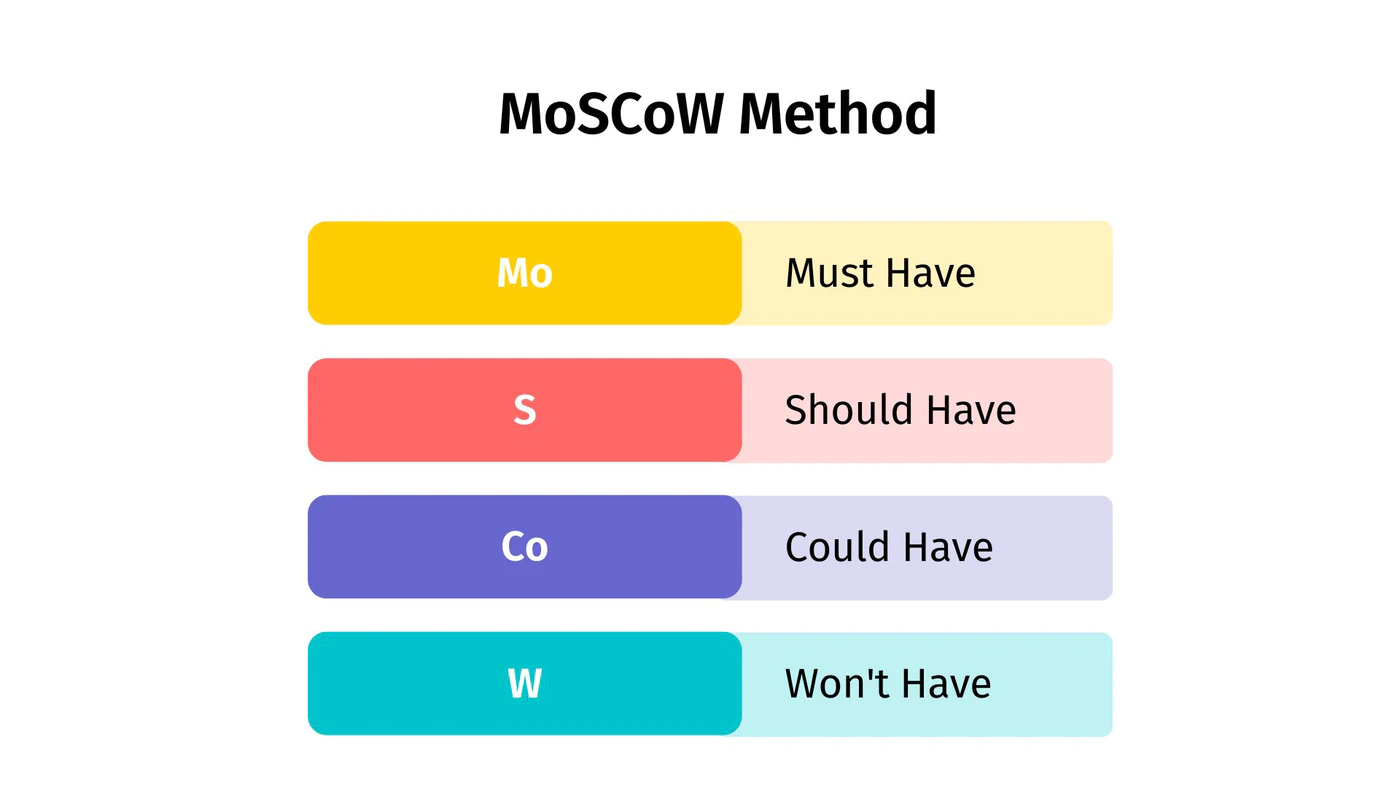
Must Have
- Needs a way of identifying objects
- Components that could blend well on the glasses
- A sensor
- A feedback loop
Should Have
- COCO SSD
- Different Styles Glasses
Could Have
- Different textured glasses
Won’t Have
- Too many ornaments on it for the final project.
Evaluation
WHAT DID I LIKE?
I liked
- Being able to experiment with what I could do with cybernetics as it is limitless.
- Understanding how to place my ideas in alignment with the brief
WHAT DIDN’T I LIKE?
- Research, I don’t enjoy this phase as much as other people.
PLANS FOR NEXT TIME:
- How can I make this a real product?
- Experiment with different methods of making this product.
References
- History of Cyborgs and Bodies
- Cyborgs
- Tech VS Humanity
- Eye Health
- Ray Ban Smart Glasses
- Envision Glasses
- Arduino Sensor
- COCO SSD
IDEATION
WHAT I DID THIS WEEK
My Initial idea was to try and recreate some aesthetically funky glasses, however, it didn’t work out in the end since my target market was the everyday consumer with short-distance eyesight. However, it did look like the YZY glasses that came out in 2022

I also didn’t like how envision glasseswere so outlandish that the person wearing them didn’t look normal. I thought it would be glasses that someone would definitely enquire about in their head and not in a good way. So I decided to look at the Specsavers collection for a normal sense of glasses and tried replicating from that – just for space with a sensor.

I went with the circle looking ones, just for prototyping puposes.

I quite liked how it looked on paper because I had sketched it out for 3d modelling, it would be easy and low poly to make.
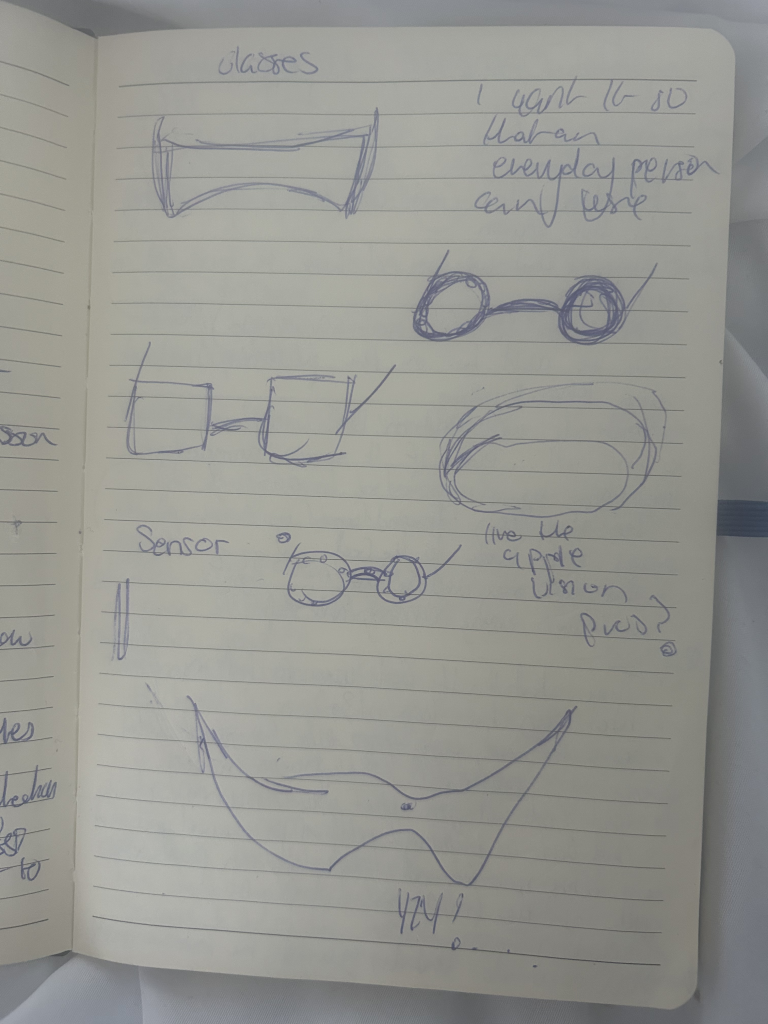
I also thought about inserting the live feedback into the lens. This article has a segment on smart glasses, and how it is done. I am thinking about a similar approach for my product.
The sensor and chip however, I am unsure.
Evaluation
WHAT DID I LIKE?
I liked
- Coming up with design ideas for my product, alongside with immersing other references from everyday life.
- Thinking and understanding my POTENTIAL market audience if I wanted it to be taken further
- Evaluating the technical side of my project, and how it could be done
WHAT DIDN’T I LIKE?
- Not being able to be completely original, as smart glasses already exist.
PLANS FOR NEXT TIME:
- Exploring more design concepts of glasses.
- Researching more technical methods of how my glasses can be made into a real-life product
References
Production
P5.JS / COCO SSD
- I got this template from the Coding Train
- I changed the code to make it personalised and unique to my glasses. I thought red was a stand-out colour and not too harsh on the eyes. – although I could’ve coloured it darker.
Code.
BLENDER
- I retrieved some references for the glasses and decided to create a low polygon version of it.
- added two toruses and resized them to make the frame of the lens
- Next I made one rectangle and extruded and moved it down gradually after a point to make the shape where the glasses would be on the ears
- I filled the texture of the lens with the P5 video to give an example of how it would work – unfortunately, I filled it out the wrong way. It is supposed to be on the interior not exterior
- I textured all materials in black
- I exported and rendered it in EVEE
- Final results
Evaluation
WHAT DID I LIKE?
I liked
- Coming up with design ideas for my product, alongside with immersing other references from everyday life.
- Thinking and understanding my POTENTIAL market audience if I wanted it to be taken further
- Evaluating the technical side of my project, and how it could be done
WHAT DIDN’T I LIKE?
- Not being able to be completely original, as smart glasses already exist.
PLANS FOR NEXT TIME:
- Exploring more design concepts of glasses.
- Researching more technical methods of how my glasses can be made into a real-life product
References
Final Evaluation
Review
This project is a solution to how the interaction between the exploration of humans, optical and cybernetics are used to help others – in this case the visually impaired(short-sighted). I believe with more time, the prototype could be further developed on Blender by creating a more intricate version and using CYCLES instead of EVEE to render it.
Eventually, that would lead me to 3D print it on the UAL CCI Campus.
Evaluation
WHAT DID I LIKE about this project?
I liked
- Being able to solve a techno-social issue through creating products for a market. I enjoy product design, so it was fulfilling.
- Understanding how cybernetics can be used to help people in every avenue of life. – Technology is not limited in this era
- Doing research on the target audience of my product, and enjoying engineering for the everyday person.
WHAT DIDN’T I LIKE about this project?
- Not having more time to develop my idea. – It would’ve been nice to properly render it and print it
- Being unable to recognise mistakes on blender till afterwards
WHAT HAVE YOU LEARNED?
- The cybernetics field is useful everywhere in every field if you can think of a solution for a problem.
- That technology depends on humans and vice versa.
PLANS FOR moving this project forward :
- Exploring more design concepts of glasses to prototype
- Understanding how to bring it to a real-life prototype
Project Two: EXPLORING CYBERNETICS IN THIRD WORLD COUNTRIES (DIY ELECTRONICS)
Introduction / Why this project?
On this project I wanted explore how people in third world countries come up with clever ways of implementing cybernetics in everyday life. It is interesting as I have found out when you have less access to work with certain level of technology, or anything in that matter – is when your brain is the most creative. I decided to put this theory to the test by attending a CCI Workshop and building a DIY Synth Turntable – with only limited items, I was able to make a turntable that made a different frequency sound when I pressed each nail
Research and Background
- BACKGROUND
In third world countries, it is often seen as a limitation to not have acess to certain items or technology unfortunately because of their environment and infrastracture. However It can also been seen as an advantage, in this way the brain can think of new and unique ideas and inventions to not only help their community, but the world.
For example DJ BOSBOSS from Kenya is a self taught electricion, DJ and artist that is making DJ DIY decks out of his everyday items.
“I was so amazed by the skills he was using and how the crowd was moving. The way he was cutting and transitioning the music Just by looking, I knew that I could do something like that using the available resources I have in the house.”
DJ BOSBOSS (PAM Interview January 25th 2024)
Although he faced alot of resistance from his original hometown Meru, as he traveled to his current town (which is also the capital city of Kenya) Nairobi, he was met with more open minded people that would embrace his invention and would eventually end him up on a famous dj set show called The Boiler Room show in the same city.
Another Example is Jamaican students Camillo Jose (CJ) Taylor, Raymond S. Markowitz and Michelle J. Johnson made a climate drone called BioScout, that monitors the ecosystem and wildlife in Jamaica.
“In the initial iteration of the course, our goal was to focus on the applications of robotics to rehabilitation in a developing country where it is necessary to create solutions that are cost effective and will work in under-resourced settings,”
Camillo Jose (CJ) Taylor
As well gaining recognition from these unique ideas, it can maybe help them out of financial distress and prevent them from succumbing to the expectations of their surroundings.
HOW DOES THAT RELATE TO YOUR WORK?
I have put together a DIY Synth (helped by DIY Electronics) to also showcase you don’t need a lot of materials to make a cyborg; sometimes less is more.
HOW WILL THIS HAPPEN?
By
- Sound Engineering
- Soldering
- Programming
Evaluation
WHAT DID I LIKE?
I liked
- Researching different tech artists that look similar to myself, reinventing technology
- Evaluating cybernetics and how it shows up in different places (ie. Sustainability or Music)
WHAT DIDN’T I LIKE?
- Not having time to research anymore engineers
PLANS FOR NEXT TIME:
- To research more engineers and make my own method to recreate their project.
References
- Digital Divide in Third World Countries
- Less Materials More Creativity
- DJ BOSBOSS PAM INTERVIEW
- DJ BOSBOSS BOILER ROOM
- BioScout
Production
HARDWARE
List of Items I used
- Nails
- Wood
- Hammer
- MicroController
- Solder
- Battery Componments
- Wire
Summary
- I first started by getting the piece of wood and nailing the nails into each part. I tried to make a cross for aesthetic reasons however it looked abit disfigured in the end.
2. I then soldered a microcontroller output to each wire, (to control the input and output of each sound)
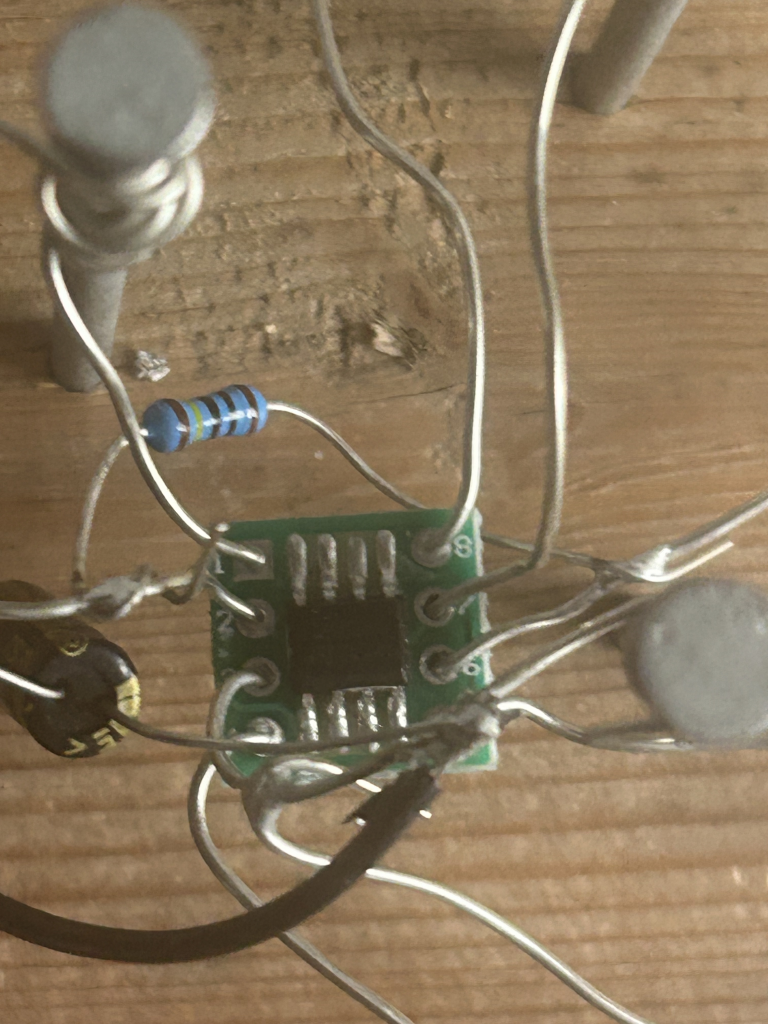
3. I then placed it at the center, and wrapped the wire around the nail so that it can be triggered when touched.
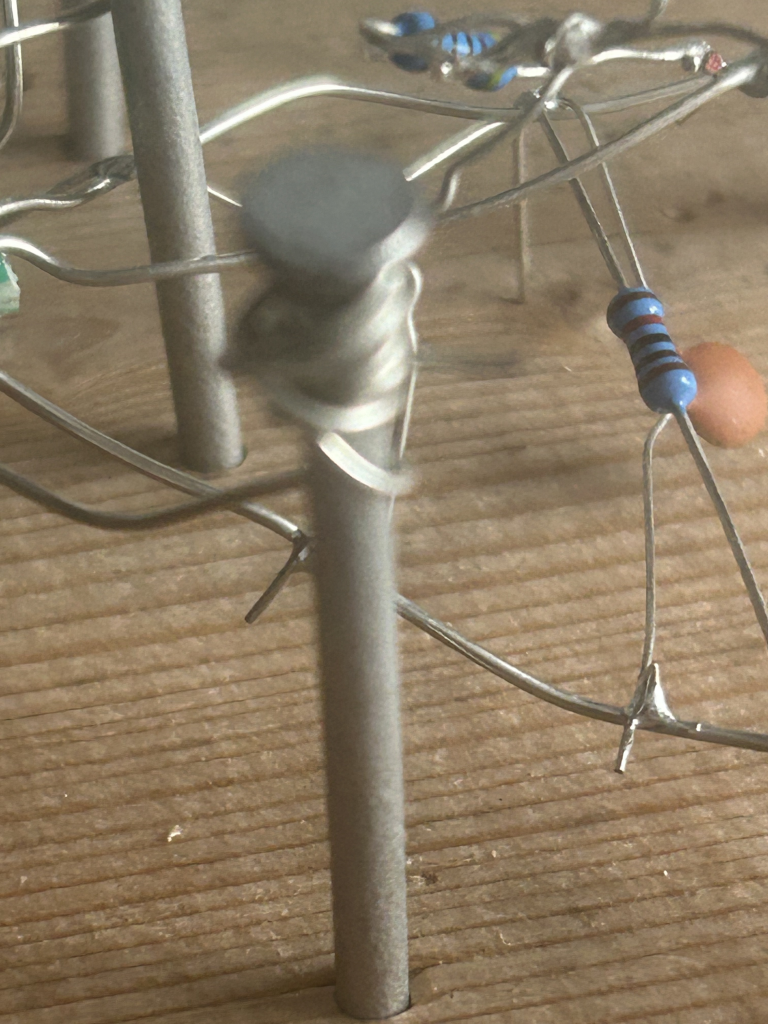
4. I soldered the battery compoments to specific outputs so that the sound would be able to play when triggered.
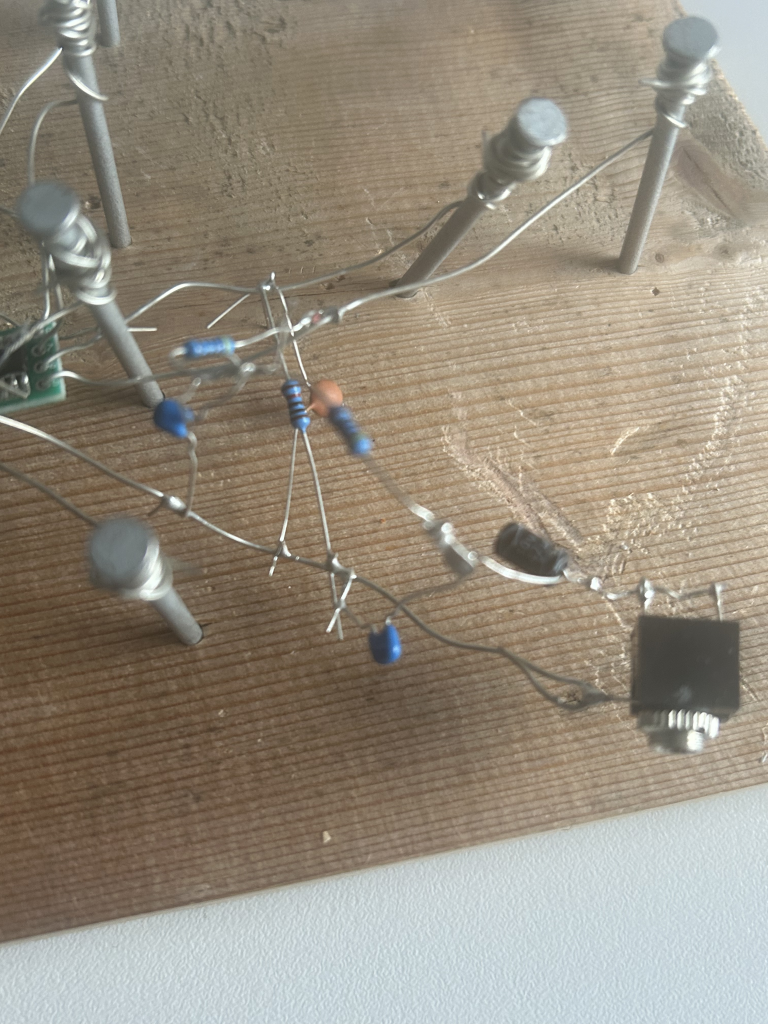
5. Next, I soldered the red battery to the wire with output two.
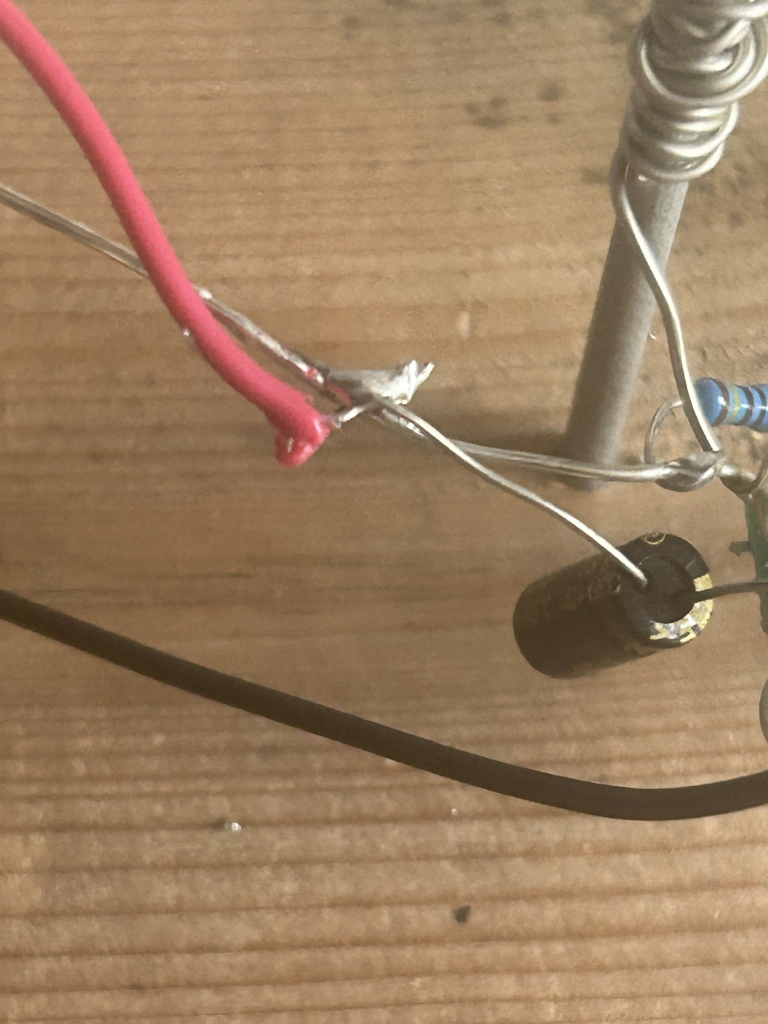
6. I plugged in my headphones and behold, an Aphex Twin sounding synthsizer made out of basic technology.
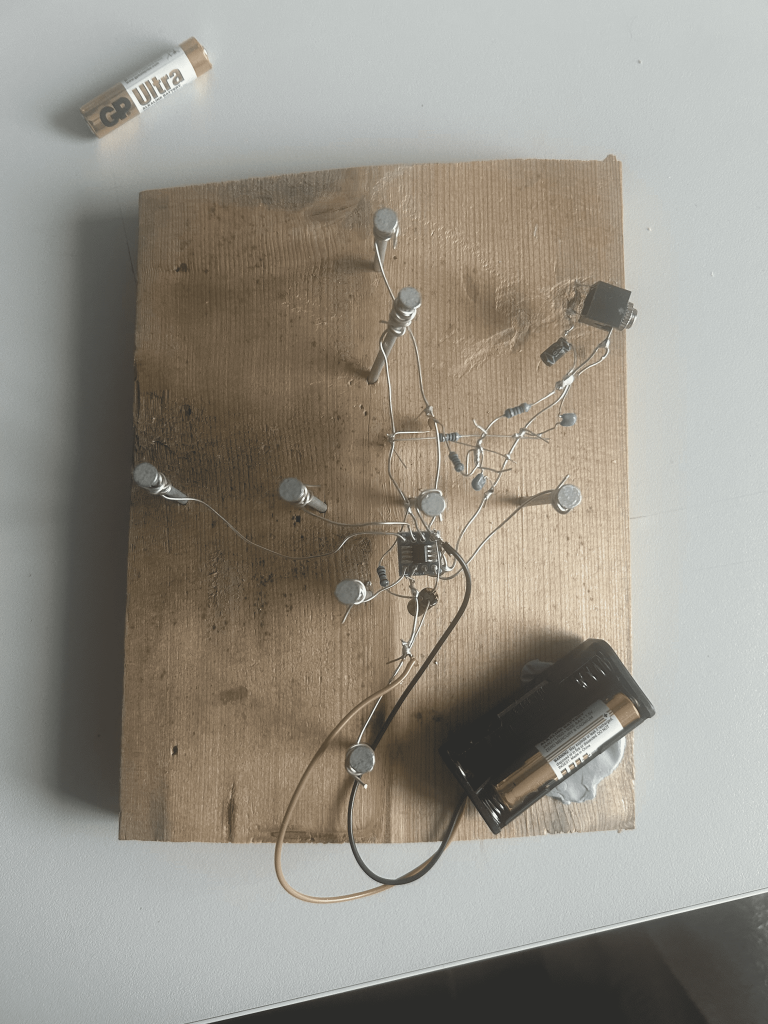
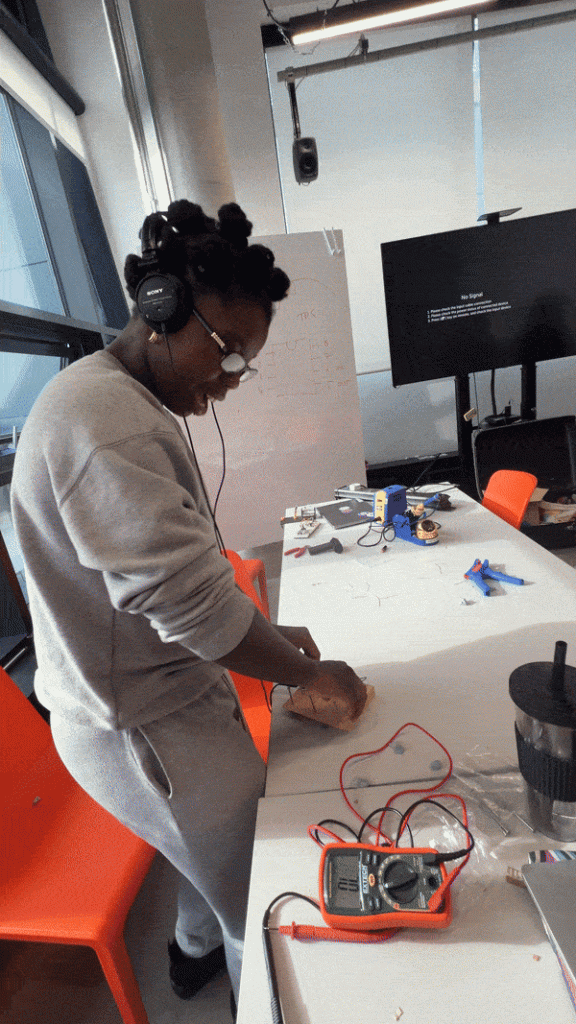
Evaluation
WHAT DID I LIKE?
I liked
- Soldering for the first time, I’ve always seen people do it but I was yet to try it.
- Exploring sound and cybernetics as I have an interest in hardware, sound and engineering
WHAT DIDN’T I LIKE?
- How aesthetically unpleasant it came out, but there is always a first for everything.
PLANS FOR NEXT TIME:
- Understanding the theory behind what I was doing.
Final Evaluation
Review
This project is an example on how having little materials can creatively be better than having accesss to alot of materials.
WHAT DID I LIKE about this project?
I liked
- Being able to demonstrate a techno-social issue through hardware, audio and creativity. It was very rewarding and I am interested in hardware and sound design.
- Understanding how cybernetics can be used even without the advanced materials.
- Knowing people in third world countries can attempt to make inventions with cybernetics.
WHAT DIDN’T I LIKE about this project?
- Not having time to understand my invention, as it was in a workshop
- Being unable to research more creative people in the beginning stages.
WHAT HAVE YOU LEARNED?
- That cybernetics can be used all over the world, even with limited materials
- That cybernetics and technology, is useable in any and every field.
PLANS FOR moving FORWARD
- Using less to make more.